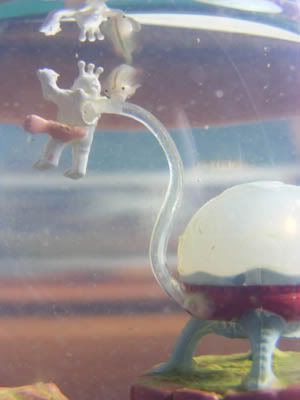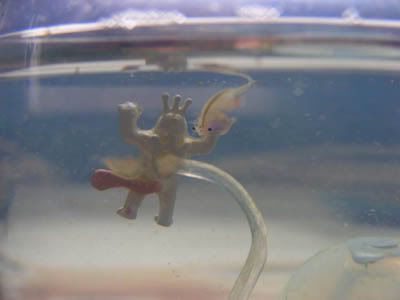
Male sea monkey with astronaut and spaceship
My current colony are the result of draining the bulk of the existing water out and restarting it again with a fresh packet of water 'purifier'* and eggs. It seems the fruits of the existing colony's last members were just not potent enough. I've since tried boosting the numbers by allowing water to evaporate over months, then adding fresh distilled water during the warmer Summer months**. This does cause babies to hatch but they don't seem to live long, though it wasn't the case with the first generation hatched this way. Since sea monkeys are type of a wild brine shrimp perhaps they have been bred to not procreate prolifically with success. There's no money in it if you could be completely self-sustaining is there?! No, you will need to buy a fresh packet of eggs thank you very much [ker-ching!].

Sea monkeys on Mars, top view through access aperture.
Note the verdant, 3 year growth of algae over the Martian surface. The accumulation of loose, green crud at the base of the tank is part of their ecosystem. It is green from algae and will contain some eggs. This type of algal growth is not only healthy but self sustaining. It should not be thrown out! The sea monkeys eat algae, digest it, and the algae turns the excretions into more algae.
Keeping the tank on a south facing window sill*** ensures plenty of gentle daylight throughout the day, with only the last rays of the sun at the end, which will not overheat the water and kill everything! It helps the algae grow and the sea monkeys need it as well. If you don't have such a suitable window sill you can place a small object like a picture frame, or a sheet or paper in front of the tank on a sunnier sill to stop direct sunlight hitting the tank. A sheer curtain is also fine to filter out direct sunlight.
Sea monkey males are sexually aggressive, latching on to females with their 'moustaches' in spite of persistant, wriggling feminine resistance. They stay attached for hours. In lieu of an available female, the sea monkey astronaut has appendages which make it an appealing sea monkey sex doll. Again these males will stay attached for hours. I have sometimes blown bubbles via a pipette to dislodge an elderly male from the astronaut, and once I intervened when two males attached to one female. Otherwise I leave them to it.

Male sea monkey in action...you can't see his many little swimming legs because this was a long exposure picture (no puns intended!).
Blowing bubbles - without sucking up water - is not only the safest way to move sea monkeys but they seem to enjoy it. It is part of maintaining a colony since it adds oxygen to the water. This set comes with such a pipette though you can buy similar ones from a chemist. An eyedropper tends to be too short for the task.
Website of the Day
Sea monkey Mania with more down to earth information and tips than the official Sea Monkey website, plus reviews of various sea monkey products
*Actually salts and a small number of eggs.
**It's the best time to raise sea monkey babies since they are from warmer climes.
***In the southern hemisphere only. Put on a northern window in the northern hemisphere.
2 comments:
Hello
Nice article and pics
Do you mind if I use your article for my Sea Monkey website?
Id also like to use your pictures as well if that is ok?
www.seamonkeysrule.info
Thanks Sea Monkey
Thank you :) Yeah that's fine. Just post photo credits and a link back here and it's good to go.
Post a Comment